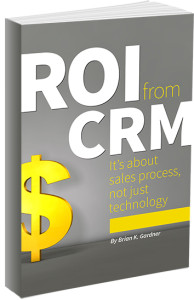29
May
How can focused account profiling promote business growth?
Last week during a CRM roundtable webinar I hosted with MCAA, we discussed ways to use CRM data to make better business decisions. One of the hot topics was Account Profiling and how using a 4-dimensional approach can help grow your business volume with focus on where your sales team should spend their time. You may say, “We have a profiling system and we grade our accounts.” In my experience, the information is usually only 1-dimensional; basing it off current or the past years business volume and not growing volume. This is where the 4-dimensional approach becomes invaluable.
19
Oct
Modern CRM systems collect large volumes of data that can be used to better manage people, products, business opportunities and more. Without the help of filters and views to make sense of these data, though, it would be overwhelming if not impossible to draw any useful conclusions from them.
16
May
Last week, I got this question from a webinar attendee while tying up my ROI from CRM webinar series with MDM: Are back-end or front-end KPIs more important? During my presentations, webinars and consulting jobs, I focus a lot on the front end of the sales cycle.
18
Apr
As a sales manager for a major industrial distribution company for 15 years before founding SalesProcess360, I gained firsthand experience in establishing successful sales processes driven by customer relationship management.
29
Oct
 In the second webcast of the MDM-SalesProcess360 quarterly series, Brian Gardner, author of ROI from CRM: It’s About Sales Process, Not Just Technology, will home in on a critical part of that process: sales opportunity management.
In the second webcast of the MDM-SalesProcess360 quarterly series, Brian Gardner, author of ROI from CRM: It’s About Sales Process, Not Just Technology, will home in on a critical part of that process: sales opportunity management.
Learn more about this webinar here or register now.
19
Oct
 Join Reed Stith, our newest addition to the SalesProcess360 team, for a quick 30-minute webinar on sales opportunity management on Oct. 28 at 11-11:30 ET.
Join Reed Stith, our newest addition to the SalesProcess360 team, for a quick 30-minute webinar on sales opportunity management on Oct. 28 at 11-11:30 ET.
In this webinar, Stith will provide three practical insights to guide your team as it shifts from a reactive to a proactive mindset when it comes to acting on sales opportunities in both existing and new accounts.
Did you miss this webinar? Register and watch it on-demand!
10
Oct
At SalesProcess360, we put a premium on processes around the front end of the sales cycle, which includes lead and opportunity management.
Quotes and orders make up the back-end of the sales cycle, and that is where most distribution companies spend their time.
What’s wrong with managing at the quote stage?
16
May
 I’m excited to announce my new book, ROI from CRM: It’s About Sales Process, Not Just Technology, is now available from MDM. Order your copy here.
I’m excited to announce my new book, ROI from CRM: It’s About Sales Process, Not Just Technology, is now available from MDM. Order your copy here.
My goal with this book was to provide simple yet effective strategies to get the most from customer relationship management. When you read this book, you will learn how to approach CRM as a system for leveraging knowledge throughout your business, and gain an edge with a revamped sales process and engaged team.
26
Jan
Many companies struggle to identify what an “opportunity” truly is. An opportunity is a qualified lead. It’s not rumor of potential business. It has real potential to move to the quote stage. (Learn what a qualified lead is in this blog post.)
11
Jan
Where do you get your leads from, and how do you know they are qualified?
Leads are the start of the sales cycle. They are part of what I call the front end of the sales process (along with opportunities). A lead is a broadly defined term that includes potential customers that may have shown interest in your products and services. Key word here is interest. At this stage, the lead is not yet qualified. You may refer to them as prospects.




 In the second webcast of the MDM-SalesProcess360 quarterly series, Brian Gardner, author of
In the second webcast of the MDM-SalesProcess360 quarterly series, Brian Gardner, author of  Join Reed Stith, our newest addition to the SalesProcess360 team, for a
Join Reed Stith, our newest addition to the SalesProcess360 team, for a 